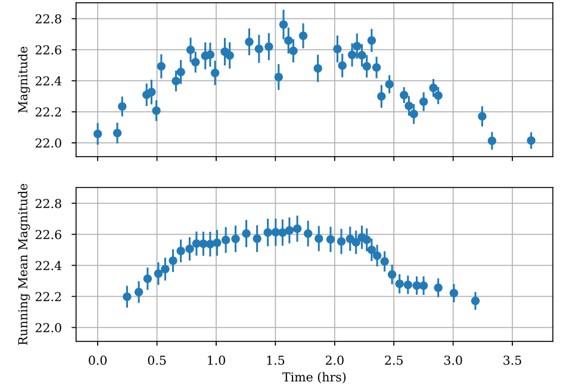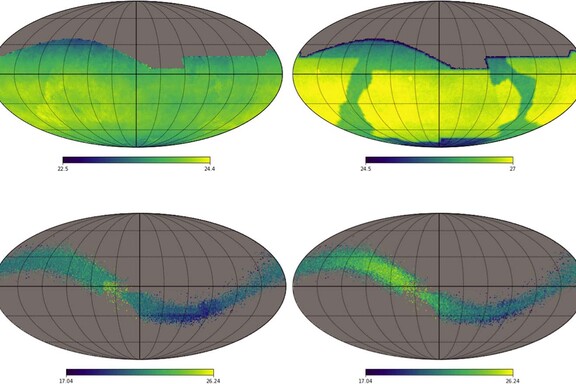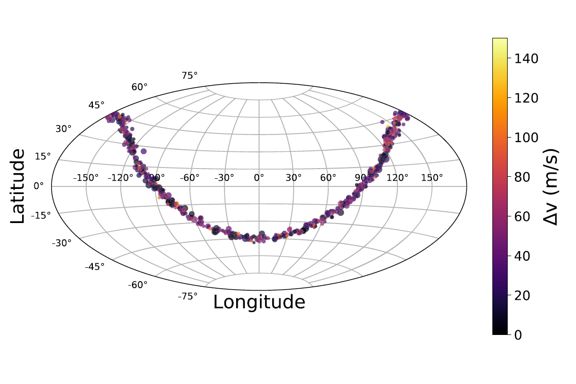The Ragozzine research group studies exoplanets and Kuiper Belt Objects using theoretical orbital dynamics, advanced statistical techniques, computational data analysis, and the best astronomical data.
Selected Publications

We present the first set of trans-Neptunian objects (TNOs) observed on multiple nights in data taken from the DECam Ecliptic Exploration Project. Of these 110 TNOs, 105 do not coincide with previously known TNOs and appear to be new discoveries. Each individual detection for our objects resulted from a digital tracking search at TNO rates of motion, using two-to-four-hour exposure sets, and the detections were subsequently linked across multiple observing seasons. This procedure allows us to find objects with magnitudes m VR approximate to 26. The object discovery processing also included a comprehensive population of objects injected into the images, with a recovery and linking rate of at least 94%. The final orbits were obtained using a specialized orbit-fitting procedure that accounts for the positional errors derived from the digital tracking procedure. Our results include robust orbits and magnitudes for classical TNOs with absolute magnitudes H similar to 10, as well as a dynamically detached object found at 76 au (semimajor axis a approximate to 77 au). We find a disagreement between our population of classical TNOs and the CFEPS-L7 three-component model for the Kuiper Belt.

We present the methods and results from the discovery and photometric measurement of 26 bright VR > 24 trans-Neptunian objects (TNOs) during the first year (2019–20) of the DECam Ecliptic Exploration Project (DEEP). The DEEP survey is an observational TNO survey with wide sky coverage, high sensitivity, and a fast photometric cadence. We apply a computer vision technique known as a progressive probabilistic Hough transform to identify linearly moving transient sources within DEEP photometric catalogs. After subsequent visual vetting, we provide a photometric and astrometric catalog of our TNOs. By modeling the partial lightcurve amplitude distribution of the DEEP TNOs using Monte Carlo techniques, we find our data to be most consistent with an average TNO axis ratio b/a < 0.5, implying a population dominated by non-spherical objects. Based on ellipsoidal gravitational stability arguments, we find our data to be consistent with a TNO population containing a high fraction of contact binaries or other extremely non-spherical objects. We also discuss our data as evidence that the expected binarity fraction of TNOs may be size-dependent.

The Vera C. Rubin Observatory is expected to start the Legacy Survey of Space and Time (LSST) in early to mid-2025. This multiband wide-field synoptic survey will transform our view of the solar system, with the discovery and monitoring of over five million small bodies. The final survey strategy chosen for LSST has direct implications on the discoverability and characterization of solar system minor planets and passing interstellar objects. Creating an inventory of the solar system is one of the four main LSST science drivers. The LSST observing cadence is a complex optimization problem that must balance the priorities and needs of all the key LSST science areas. To design the best LSST survey strategy, a series of operation simulations using the Rubin Observatory scheduler have been generated to explore the various options for tuning observing parameters and prioritizations. We explore the impact of the various simulated LSST observing strategies on studying the solar system's small body reservoirs. We examine what are the best observing scenarios and review what are the important considerations for maximizing LSST solar system science. In general, most of the LSST cadence simulations produce +/- 5% or less variations in our chosen key metrics, but a subset of the simulations significantly hinder science returns with much larger losses in the discovery and light-curve metrics.

Dozens of families of asteroids in the asteroid belt have similar orbits and compositions because they formed through a collision. However, the icy debris beyond the orbit of Neptune, called the Kuiper Belt, contains only one known family, the Haumea family. So far, no self-consistent explanation for the formation of the Haumea family can match all geophysical and orbital characteristics of the family without invoking extremely improbable events. Here, we show that the family is adequately explained as the product of a merging binary near the end of Neptune’s orbital migration. The unique orbital signature of a merging binary, which was not found in extensive searches, is effectively erased during the final stages of migration, providing an explanation for all aspects of the Haumea family. By placing the formation of the Haumea family in the broader context of solar system formation, we demonstrate a proof-of-concept model for the formation of Haumea.

Population studies of Kepler's multiplanet systems have revealed a surprising degree of structure in their underlying architectures. Information from a detected transiting planet can be combined with a population model to make predictions about the presence and properties of additional planets in the system. Using a statistical model for the distribution of planetary systems, we compute the conditional occurrence of planets as a function of the period and radius of Kepler-detectable planets. About half (0.52 +/- 0.03) of the time, the detected planet is not the planet with the largest semi-amplitude (K) in the system, so efforts to measure the mass of the transiting planet with radial velocity (RV) follow up will have to contend with additional planetary signals in the data. We simulate RV observations to show that assuming a single-planet model to measure the K of the transiting planet often requires significantly more observations than in the ideal case with no additional planets, due to systematic errors from unseen planet companions. Our results show that planets around 10 day periods with K close to the single-measurement RV precision (sigma (1,obs)) typically require similar to 100 observations to measure their K to within 20% error. For a next generation RV instrument achieving sigma (1,obs) = 10 cm s(-1), about similar to 200 (600) observations are needed to measure the K of a transiting Venus in a Kepler-like system to better than 20% (10%) error, which is similar to 2.3 times as many as would be necessary for a Venus without any planetary companions.

Early analyses of exoplanet statistics from the Kepler mission revealed that a model population of multiplanet systems with low mutual inclinations (similar to 1 degrees-2 degrees) adequately describes the multiple-transiting systems but underpredicts the number of single-transiting systems. This so-called "Kepler dichotomy" signals the existence of a subpopulation of multiplanet systems possessing larger mutual inclinations. However, the details of these inclinations remain uncertain. In this work, we derive constraints on the intrinsic mutual inclination distribution by statistically exploiting transit duration variations (TDVs) of the Kepler planet population. When planetary orbits are mutually inclined, planet-planet interactions cause orbital precession, which can lead to detectable long-term changes in transit durations. These TDV signals are inclination sensitive and have been detected for roughly two dozen Kepler planets. We compare the properties of the Kepler-observed TDV detections to TDV detections of simulated planetary systems constructed from two population models with differing assumptions about the mutual inclination distribution. We find strong evidence for a continuous distribution of relatively low mutual inclinations that is well characterized by a power-law relationship between the median mutual inclination ((mu) over tilde (i,n)) and the intrinsic multiplicity (n):(mu) over tilde (i,n) = (mu) over tilde (i,5)(n/5)(alpha), where (mu) over tilde (i,5 )=1.10(-0.11)(+0.05) and alpha =-1.73(-0.08)(+0.09) These results suggest that late-stage planet assembly and possibly stellar oblateness are the dominant physical origins for the excitation of Kepler planet mutual inclinations.